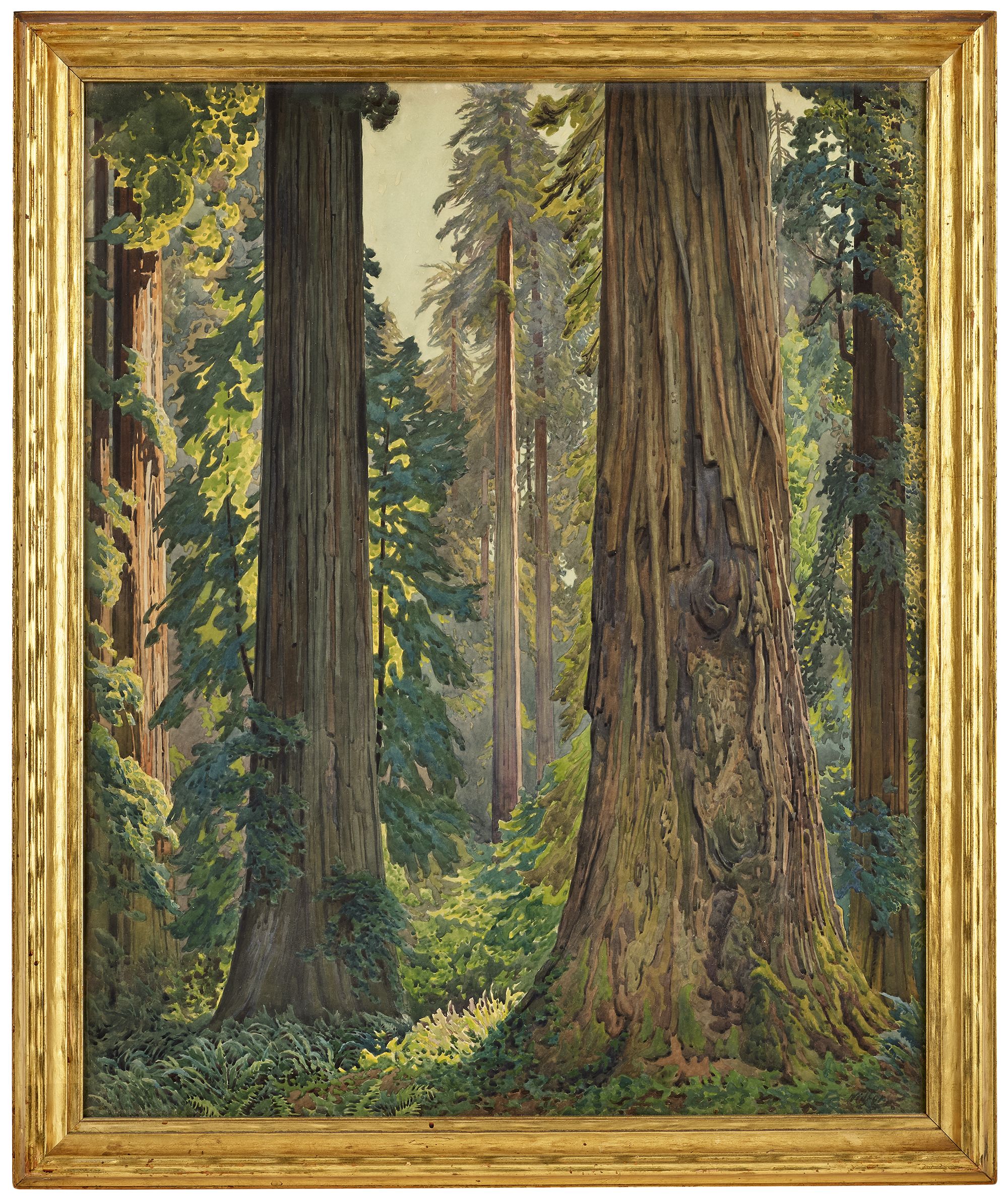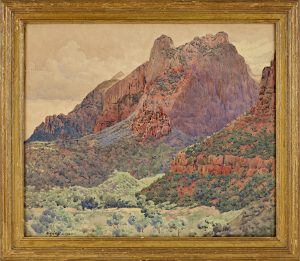Painter of the National Parks

Two very exciting paintings grace the October 5th and 6th Americana & International auction at Pook & Pook. Collectors will have the opportunity to acquire works by a recently rediscovered artist of international renown, who played an important role in promoting National Park landscapes to the American public.
Gunnar Widforss (Sweden, United States, 1879-1934) roamed the world looking for beautiful landscapes. Born in Sweden, he earned a living in the first decades of the 20th century plein air painting in spa towns and scenic spots around the Mediterranean, where he was in proximity to both beauty and a customer base. He achieved success, having two paintings accepted in the Paris Salon. In 1921 he began a journey to Japan, which ended when he ran out of money in California. While there, Widforss fell back on his work formula of scenery and tourists, painting Catalina Island and popular places along the coast. His life changed in March of that year when he journeyed to Yosemite National Park. The landscape and light, the solid rock and the miles of atmosphere, captured his imagination. His painting of the park was encouraged by his friend Stephen Mather, the first Director of the National Park Service. Mather recognized the historical contribution of artists in preserving public lands, establishing the parks as a source of national pride and identity. Mather encouraged Widforss to focus on the parks, and Widforss found his calling, quickly gaining a reputation as the painter of our national parks. The Park Service, the Santa Fe Railroad, and hotels all commissioned paintings for posters and promotions. In 1924 the National Gallery of Art in Washington D.C. showed 72 Widforss watercolors, with Gallery Director W.H. Holmes calling the paintings “the finest things of their kind that have come out of the West. (Widforss) is possibly the greatest watercolorist in America today.” Exploring the parks, Widforss spent an increasing amount of time at the South Rim of the Grand Canyon, which inspired the paintings for which he became best known.
For Gunnar Widforss, the year 1929 was a watershed. He turned fifty. Gump’s in San Francisco held his most successful show. He became an American citizen. Then, he witnessed the onset of the Great Depression. The numbers of park tourists and customers dwindled and dried up. The New Deal WPA for artists would not begin until 1933. Widforss wrote to his mother, “I will get a tent, a cot, something to cook on and a couple of cans of beans or such. A little coffee too, maybe I can arrange to live a little cheaper that way.” Previously accustomed to trading paintings for room and board, Widforss retreated to his tent and continued his daily painting.
As the world teetered on the brink of economic collapse, many American artists reacted by experimenting with idealized visions of the future and abstraction. Gunnar Widforss stuck fast to the realism of his western park landscapes. The vastness of the parks transcends comprehension, inspiring feelings of awe and spirituality. As such, the parks are places of the Gods. Every day, the plein air painter sat at his easel surrounded by vistas eternal and sublime. While the Depression raged on, in the parks Widforss breathed a rarefied air, exalted by a brilliant sun. Gunnar Widforss sat on canyon rims, in remote, inaccessible valleys, and at the foot of towering redwoods, and with a steady hand, crystallized those heroic landscapes into realistic, intimate visions that speak to the soul.
Widforss’s career painting the National Parks came to a tragic early end in 1934 when he suffered a heart attack near his home on the Grand Canyon’s South Rim. He is memorialized as one of only three artists for whom Grand Canyon landmarks are named. One of the most famous painters of his time, until recently, he had faded into obscurity. Collectors are now rediscovering him, largely informed by the work of Alan Petersen, Curator of Fine Art at the Museum of Northern Arizona and author of the Gunnar Widforss Catalogue Raisonne and an upcoming biography. The authority on Widforss, most of the information in this article has been drawn from Petersen’s original research.
According to Petersen, Gunnar Widforss would stay with his friend Theophil Fritzen when he was in San Francisco. Fritzen managed the Kings River Parks Company, which ran concessions in Sequoia and other National Parks in the early 1920’s. The two watercolors featured were both owned by Fritzen and passed down within his family. Still in their original frames, they have been in storage since the 1990s. Emerging into the light for the first time in years, their colors are rich and vibrant. The view of the geology and light of Zion National Park is in a warm palette, which shifts to cool for the towering great trees of Redwood National Park. In both paintings, the delicacy of color and dramatic composition capture the emotional impact of scenes of such immensity and beauty. Sharply defined rocks and tree trunks stand before limitless horizons and forest depths. The scene of Zion is dated 1923, the year Widforss was first commissioned by Park Director Stephen Mather to paint the park. Humboldt County Redwoods was painted circa 1925, when Petersen documents the artist “working at Schilling’s Inn between Scotia and Garberville” during June and July. These paintings are examples of the best of Widforss’s work.
by: Cynthia Beech Lawrence

Sources:
Alan Petersen, Gunnar Widforss: The Artist and the Myths, chapter 38, publication to be announced.
Alan Petersen, Letters from Gunnar, Sojourns, summer 2013, p. 31-41.
Alan Petersen, Gunnar Widforss, Painter of America’s National Parks, Plein air Magazine, spring 2011, p. 62-66.
National Park Service, Landscape Art and the Founding of the National Park Service.
National Gallery of Art, Uncovering America: Art and the Great Depression.
- Artist Spotlight: David Gerstein, Sculptural Pop in Bold Color & Motion
- The History of Rolex Watches: Innovation, Precision, and Enduring Prestige
- Preview the December Doyle+Design Auction: A Celebration of Modern & Contemporary Mastery
- Billings Winter Design 2025: A Celebration of Modern Mastery Across Eras
- The Ultimate Holiday Gift Guide: Luxe Finds From Bidsquare’s Finest Auctions
- Fine & Antique Jewelry Sale: A Curated Journey Through Craftsmanship & Design
- Upcoming Auction Spotlight: Doyle’s Fine Art: 19th Century & Early Modernism
- Entertain with Style This Holiday Season: Highlights from Doyle’s December 8 Auction
- Six Standout Lots from Newel’s Fine Jewelry, Timepieces & Luxury Handbags Sale
- Artist Spotlight: Roy Lichtenstein, Pop Art’s Master of Bold Lines & Bigger Ideas



 EUR
EUR CAD
CAD AUD
AUD GBP
GBP MXN
MXN HKD
HKD CNY
CNY MYR
MYR SEK
SEK SGD
SGD CHF
CHF THB
THB












